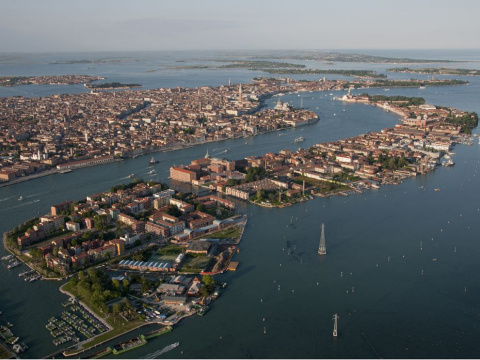Под водами Венецианской лагуны могут скрываться остатки римской дороги.
При помощи гидроакустической технологии ученым удалось обнаружить археологический материал на дне канала Трепорти, расположенного к востоку от центра Венеции. Их находки могут свидетельствовать о том, что крупные поселения возникли на этой территории на много столетий раньше, чем принято считать.
Возможно обнаружена часть дороги, соединявшая южную и северную части Венецианской лагуны и шла от Кьоджи (древней Клодии) в город Альтинум.
На полученных изображениях удалось идентифицировать 12 отрезков дороги, лежащих на линии протяженностью более чем в километр, тянувшейся, вероятно, вдоль античной береговой полосы. Длина самого крупного из отрезков составляет 52,7 м.
Во времена Древнего Рима уровень воды в Венецианской лагуне был гораздо ниже и значительную часть ее площади составляла суша. Водолазы регулярно находят на дне римские артефакты, в том числе амфоры и объекты, которые идентифицируют как брусчатку.
Историки долгое время спорили, действительно ли на этой территории располагались постоянные римские поселения за сотни лет до основания Венеции, которое принято относить к 5 веку.
Считалось, что Венеция была построена на пустынном месте, лишенном каких-либо следов присутствия человека, а находки древнеримской эпохи на дне лагуны и в придонном слое относятся к зданиям, стоявшим на окружающей лагуну суше.
Проблема связана с тем, что ученые рассматривали лагуну как отдельную от материка территорию и в последние десятилетия публиковалась информация лишь о небольшой части находок и раскопок, проведенных там.
Результаты свежего исследования указывают на то, что на землях, ныне занятых Венецианской лагуной, когда-то было множество римских поселений.
Помимо древней дороги, гидроакустическое сканирование позволило обнаружить в канале Трепорти еще четыре объекта. Один из них, площадью 700 кв. м, с круглой башней в центре, вероятно, был портом. Ученые также использовали археологические и геоморфологические данные для реконструкции микроклимата лагуны в древнеримскую эпоху и пришли к выводу, что прибрежная территория была покрыта богатой растительностью и, возможно, даже использовалась для земледелия.
Основываясь на совокупности данных, ученые утверждают, что обнаруженная дорога шла вдоль песчаного побережья лагуны и, вероятно, входила в состав обширной сети римских дорог. Если это действительно так, то она могла быть последним отрезком шедшего с юга пути, соединявшего древнюю Клодию на юге лагуны с Альтинумом на севере.
© Times of Ukraine
. . . .
Remains of a Roman road may be hidden under the waters of the Venetian Lagoon.
Using sonar technology, scientists were able to find archaeological material at the bottom of the Treporti Canal, located east of the center of Venice. Their findings may indicate that large settlements arose on this territory many centuries earlier than it is generally believed.
It is possible that part of the road connecting the southern and northern parts of the Venetian lagoon and went from Chioggia (ancient Clodia) to the city of Altinum was discovered.
On the images obtained, it was possible to identify 12 sections of the road lying on a line more than a kilometer long, probably stretching along the ancient coastal strip. The largest of the sections is 52.7 m long.
During Roman times, the water level in the Venetian lagoon was much lower and a significant part of its area was land. Divers regularly find Roman artifacts at the bottom, including amphorae and objects that they identify as paving stones.
Historians have long argued whether permanent Roman settlements were actually located on this territory hundreds of years before the founding of Venice, which is usually attributed to the 5th century.
It was believed that Venice was built on a desolate place devoid of any traces of human presence, and the finds of the ancient Roman era at the bottom of the lagoon and in the bottom layer refer to buildings that stood on the land surrounding the lagoon.
The problem is associated with the fact that scientists considered the lagoon as a separate territory from the mainland and in recent decades, information has been published on only a small part of the finds and excavations carried out there.
Recent research indicates that the land now occupied by the Venetian Lagoon was once home to many Roman settlements.
In addition to the ancient road, hydroacoustic scanning revealed four more objects in the Treporti Canal. One of them, with an area of 700 sq. m, with a round tower in the center, was probably a port. Scientists also used archaeological and geomorphological data to reconstruct the lagoon’s microclimate during the Roman era and concluded that the coastal area was rich in vegetation and may have even been used for agriculture.
Based on the body of data, scientists argue that the discovered road ran along the sandy coast of the lagoon and was likely part of an extensive Roman road network. If this is true, then it could be the last segment of the route coming from the south, connecting ancient Clodia in the south of the lagoon with Altinum in the north.
© Times of Ukraine

